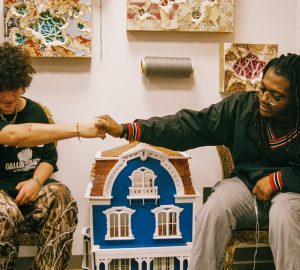Students analyze the debate beyond the words.
By Mark Ziemer
In this crazy election season, one that finally ends today, there has been a lot of talk about what the candidates say. Pundits and people alike argue over what Obama or McCain’s tax plans mean, over what candidate made the latest slip-of-the-tongue, and over who means what they say. But what about what they don’t say?
Dr. Karen Scott, Liberal Arts Professor at SCAD-Atlanta, had her students do an assignment that required them to watch the vice-presidential debate between Joe Biden and Sarah Palin (no doubt helping it be the top-rated debate of the last few cycles), and assess the candidates’ non-verbal communication. Pushing past the talking points and policy proposals of the two nominees, several students offered up their take on how Palin and Biden performed through body language and non-verbal cues. This is important because, as Chelsey Collins, a second-year fashion design student, noted: “[The candidate’s] non-verbal actions were just as significant because it helped those watching further understand the points being made and the individuals stating these points.”
Part of non-verbal communication includes one’s appearance, as some students found the choice of wardrobe by the two candidates a positive aspect. Sarah Yoon, a second-year illustration student said that attire “provided a sense of professionalism” and served to not create a distraction. Conversely, Miranda Bradley, a second-year animation student, found that Palin’s accessories were “large and sparkled” and stated that they served as distractions that managed to draw one’s attention away. “She had too much clutter that served as noise to the viewer,” she remarked. She was keener on Biden’s choice of a blue tie and suit, which she found calming.
More striking was the way many students reacted to the candidates’ body language. While nobody said that Palin performed less ably, many noted that she seemed to be lacking in professionalism, or at least in being able to project calm. Bradley continued her critique, stating that Governor Palin created a “feeling of stress” in viewers due to her “shifty, nervous movements, often swaying, looking around, and moving jerkily.”
Many, including Emerald Sims, a second-year fashion design student, picked up on Palin’s several winks and nods over the course of the debate. Sims thought she looked “liked a news anchor,” and “felt it was inappropriate.” Collins, on the other hand, attributed the differences to gender and expectations.
Where Palin was received with mixed feelings by the students, most seemed to find Senator Biden a confident, more commanding presence. Bradley, Collins and Sims all reacted relatively favorably to Biden’s body language, and remarked that Biden’s numerous hand gestures communicated importance and emphasis. Sims found his movements “natural, which exuded a level of confidence.” Yu Mi Lee, a fourth-year broadcast design student noted that the senator’s “eye contact makes the audience feel comfortable and conversational.” Not everything was perfect, though. Yoon picked up on the few times Biden demonstrated “visible signs of heated emotion and irritation.”
Overall, all of the students managed to offer their critiques in a nonpartisan, analytical way that informed the readers of the importance of non-verbal communication. Differences were noted and analyzed, and several students also expressed that this assignment increased their awareness of nonverbal communication. Maybe in four years, at the next presidential debate, people will put equal importance on not just what the candidates say, but what they reveal behind all the words.
























